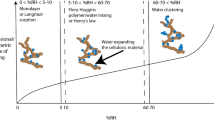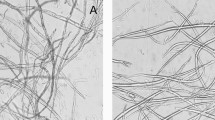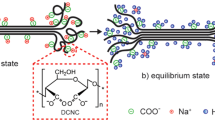Abstract
DURING an investigation of the surface properties of cellulose the relationship between the contact angle of water on cellulose and the water content of the cellulose was determined. The determination of the water-cellulose-air contact angle was done with the sessile drop method on regenerated cellulose films, and with the vertical rod method using thick cellulose fibres. (The model filaments of P. H. Hermans1). The contact angle of water on cellulose was determined at 20° C. in a gas phase consisting of air with a relative humidity with which the cellulose films and fibres of different water content were in equilibrium. Changes in the water content of the cellulose, ranging from 0 to 25.9 per cent absorption, were obtained by keeping the cellulose at 20° C. in air of different relative humidities varying from 0 to 95 per cent.
This is a preview of subscription content, access via your institution
Access options
Subscribe to this journal
Receive 51 print issues and online access
$199.00 per year
only $3.90 per issue
Buy this article
- Purchase on Springer Link
- Instant access to full article PDF
Prices may be subject to local taxes which are calculated during checkout
Similar content being viewed by others
References
Hermans, P. H., “Contributions to the Physics of Cellulose Fibres”, (Amsterdam-Brussels, 1946).
Author information
Authors and Affiliations
Rights and permissions
About this article
Cite this article
JOUBERT, J., KRIGE, G. & BORGIN, K. Evidence for a Hydrate of Cellulose from Studies of its Surface Properties. Nature 184, 1561–1562 (1959). https://doi.org/10.1038/1841561b0
Issue Date:
DOI: https://doi.org/10.1038/1841561b0
Comments
By submitting a comment you agree to abide by our Terms and Community Guidelines. If you find something abusive or that does not comply with our terms or guidelines please flag it as inappropriate.



